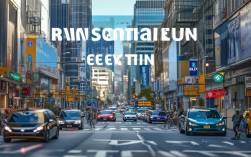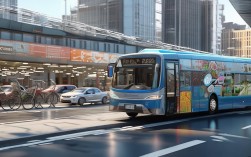日常交流中的交通话题
在日常生活中,交通是一个高频话题,无论是与朋友闲聊、商务沟通还是旅行规划,掌握相关的表达方式都能让交流更自然流畅,以下从不同场景出发,提供实用的口语范例,帮助提升表达能力。

日常出行与交通方式
选择合适的交通工具是日常讨论的常见内容,以下是一些基础表达:
-
询问出行方式
- "How do you usually get to work?"(你通常怎么上班?)
- "What’s the best way to travel downtown?"(去市中心最好的方式是什么?)
-
描述常用交通方式
- "I take the subway every day. It’s faster than driving."(我每天坐地铁,比开车快。)
- "She prefers cycling because it’s eco-friendly."(她更喜欢骑行,因为环保。)
-
讨论交通优缺点
- "Buses are cheap, but they can be crowded during rush hour."(公交车便宜,但高峰期很拥挤。)
- "Driving gives you more flexibility, but parking is a headache."(开车更灵活,但停车很麻烦。)
公共交通系统
在城市中,公共交通是重要的话题,以下是一些实用表达:
-
询问路线信息
- "Which bus goes to the museum?"(哪路公交车去博物馆?)
- "How often do the trains run on weekends?"(周末火车多久一班?)
-
描述乘车体验
- "The subway system here is efficient and clean."(这里的地铁系统高效又干净。)
- "I missed the last train, so I had to take a taxi."(我错过了末班车,只能打车了。)
-
公共交通卡使用
- "Do you need to tap in and tap out with the metro card?"(坐地铁需要刷卡进站和出站吗?)
- "You can recharge the card at any convenience store."(便利店可以给交通卡充值。)
交通出行问题与解决方案
交通拥堵、延误等问题是讨论的热点,以下是一些表达方式:
-
抱怨交通状况
- "The traffic was terrible this morning. I was stuck for an hour!"(今天早上的交通太糟糕了,堵了一小时!)
- "Flight delays are so frustrating. I’ve been waiting at the airport for three hours."(航班延误太烦人了,我在机场等了三小时。)
-
提出解决方案
- "We should leave earlier to avoid rush hour."(我们应该早点出发避开高峰期。)
- "Maybe we can carpool to save time and money."(或许我们可以拼车,既省时又省钱。)
-
紧急情况处理
- "My car broke down on the highway, so I called a tow truck."(我的车在高速上抛锚了,我叫了拖车。)
- "If you miss the bus, there’s always the option of grabbing a ride-sharing service."(如果错过公交车,还可以叫网约车。)
旅行与长途交通
旅行时,长途交通的选择和体验是重点话题:
-
选择交通工具
- "I’m taking a overnight train to save on accommodation."(我坐夜火车去,这样可以省住宿费。)
- "Flying is quicker, but train travel is more scenic."(飞机更快,但火车旅行风景更好。)
-
机场与车站相关表达
- "Where can I check in for my flight?"(在哪里办理登机手续?)
- "The boarding gate is B12. Please proceed there now."(登机口是B12,请立即前往。)
-
旅行建议
- "Book your train tickets in advance, especially during holidays."(假期期间要提前预订火车票。)
- "Arrive at the airport at least two hours before your flight."(至少提前两小时到达机场。)
未来交通趋势
随着科技发展,未来交通方式成为讨论热点:
-
新兴交通技术
- "Self-driving cars might become common in the next decade."(未来十年自动驾驶汽车可能会普及。)
- "Electric scooters are a convenient short-distance transport option."(电动滑板车是短途出行的便捷选择。)
-
环保交通
- "More people are choosing electric vehicles to reduce carbon emissions."(更多人选择电动车以减少碳排放。)
- "Cycling lanes are being expanded to promote green transportation."(正在扩建自行车道以推广绿色出行。)
-
智慧交通系统
- "Smart traffic lights can reduce congestion by adjusting timing based on traffic flow."(智能交通信号灯可根据车流调整时间,减少拥堵。)
- "Real-time transit apps help passengers plan their trips more efficiently."(实时交通应用能帮助乘客更高效地规划行程。)
交通方式对比表
| 交通方式 | 优点 | 缺点 | 适用场景 |
|---|---|---|---|
| 地铁 | 快速、准时、避开地面拥堵 | 站点固定、可能拥挤 | 城市内中长途通勤 |
| 公交车 | 覆盖广、票价低 | 速度慢、受路况影响大 | 短途出行、预算有限时 |
| 自行车 | 环保、灵活、锻炼身体 | 受天气影响、距离受限 | 短途出行、城市内 |
| 出租车/网约车 | 便捷、门到门服务 | 费用高、高峰期可能难叫车 | 赶时间、携带行李多时 |
| 私家车 | 自由度高、舒适 | 停车难、养车成本高 | 家庭出行、长途旅行 |
相关问答FAQs
Q1: 如何用英语礼貌地向他人询问路线?
A: 可以使用以下表达:
- "Excuse me, could you tell me how to get to the nearest subway station?"(打扰一下,请问怎么去最近的地铁站?)
- "I’m trying to find the bus stop for Line 5. Do you know where it is?"(我想找5路公交站,您知道位置吗?)
- "Could you show me on the map? I’m a bit lost."(能在地图上指给我吗?我有点迷路了。)
Q2: 如何描述交通拥堵的情况?
A: 以下是几种地道表达:
- "There’s a huge traffic jam on the highway. We’ve been moving at a snail’s pace."(高速路上堵车了,我们像蜗牛一样慢慢挪。)
- "The roads are gridlocked due to the accident. It’s going to take ages to get through."(因为事故,道路完全堵死了,要通过得花很长时间。)
- "Rush hour is unbearable today. It took me twice as long to get home."(今天高峰期简直无法忍受,回家花了两倍的时间。)











